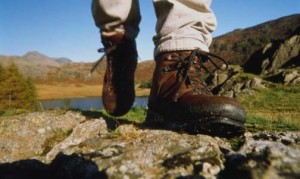
Going the distance in boots (combat, work, or hiking to name a few) that haven’t been properly broke in can leave you feeling they way I did after backpacking with the scouts in my classy chucks; sore footed and blistered. Ironically I did the same thing the next year with the scouts.
When I was young I heard that soldiers broke in boots by urinating in them and then walking around in the boots. After 15 years of military experience I can say I have yet to see a single soldier do this with his boots or even hear about it being done.
I’ve found that if you don’t mind blisters and shin splints you can do a few 4-5 mile runs in your new boots; but most people prefer a less painful method. Also, the rapid extreme flexing and stretching of the leather can be detrimental to the leather if it hasn’t been properly worked over and broke in already.
Firstly, set yourself up for success by buying the right size boots. If boots don’t fit properly to start with then they won’t break in properly. Fine and dandy for back yard gardening, not for hard labor, hiking, or bugging out.
Boot Fit Guide (sheplers.com)
Once you are standing, wearing both boots, look for these three signs of a good fit:
- Your entire foot should feel snug in the boot EXCEPT for your heel. Don’t worry! Your heel should always slip in a properly fitted new boot. As you begin wearing your boot, you will find the heel leather will soften, and your boot will then conform to and move with your foot. The slippage will disappear!
- The ball of your foot should sit at the widest part of the sole of the boot. Unlike feeling for the fit in your toes (as you would in trying on a shoe), the proper location of the ball of your foot in the boot will ensure a good fit throughout. Consequently, if the ball of your foot sits too far forward in the boot, your toes will uncomfortably crowd in the toe box of the boot.
- The instep (vamp) of the boot should fit snugly over the top of the arch of your foot (more snugly than the fit in your normal shoe or sneaker.)
Finding Your Perfect Boot Size:
- Begin with your normal shoe size. It’s a good idea to have your feet measured every year or so, as the size of your feet may change over time.
- Note that socks (even tights or nylons!) can add a 1/2 size to your feet.
- If you are an “in-between” size, we recommend ordering the larger of the two sizes you are between.
- If your feet are a narrow width (and no narrow sizes are available to purchase), you may need to order a 1/2 size smaller than your normal size.
- If your feet are a wide width (and no wide sizes are available to purchase), try ordering a 1/2 size larger than your normal size.
- Your feet may be two different sizes. We recommend ordering the size that fits the larger foot.
Standard width for a woman’s boot is “B” width (which may be labeled “M” for “Medium” width). Narrow width is labeled “A”. Wide width is labeled “C”.
Standard width for a man’s boot is “D” width. Narrow width is labeled “B”. Wide width is labeled “EE” or “EW”.
We recommend wearing boot socks with your boots. Boots socks are designed to reduce slippage and shock and provide a comfortable stay-put, over-the-calf fit to complement the tall shafts of your boots. Unlike your regular cotton socks, boot socks absorb moisture to keep your feet dry and warm, all day long.
Now you’re ready to break in your new boots.
Do:
The down and dirty is that breaking in a new pair of boots take time and patience. If you rely on a lot of rapid techniques using extreme heat and/or water you risk permanently damaging them. The best option is lacing up your boots and wearing them around your home. Perform all your normal tasks at home in your boots. To keep your feet from getting sore start with under an hour for a week or so, as little as 10 minutes a day is a reasonable start, and then gradually increase the amount of time a day you wear them.
Don’t Do:
The most common quick fix for breaking in boots is with water; either filling them up to the eyelets with water, filling them completely with water, or saturate them thoroughly. Then walking around in them for a full day. Unfortunately leather can only handle a certain amount of moisture before it begins warping and losing its original shape. Not that this method won’t work, but you walk a fine line between breaking them in, and making them totally unwearable. My experience with combat boots is that they might feel broke in the evening after prolonged exposure to moisture (wading through rivers and such), but the leather will be stiff and unyielding the next morning after it’s dried. This is especially true of new age combat boots that don’t “require” the same conditioning oils, creams, and polishes of the old style military boots. All leather requires some sort of conditioning.
It is true that your feet will often sweat and dampen the insides of boots, but prolonged water exposure and walking around in soggy boots will not only affect the leather but can also rot out stitching and other material used in their manufacturing of the boots, as well as increasing the rate of wear on those same materials. This is why military boots geared for a jungle or extreme desert environments often feature vents near the sole, both for water drainage and air circulation to reduce dampening.
Jon

Leave a Reply